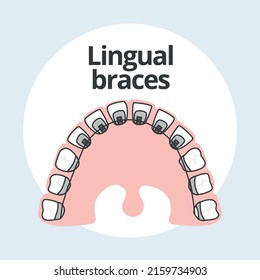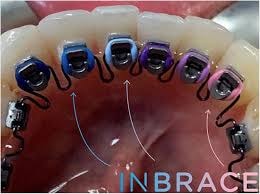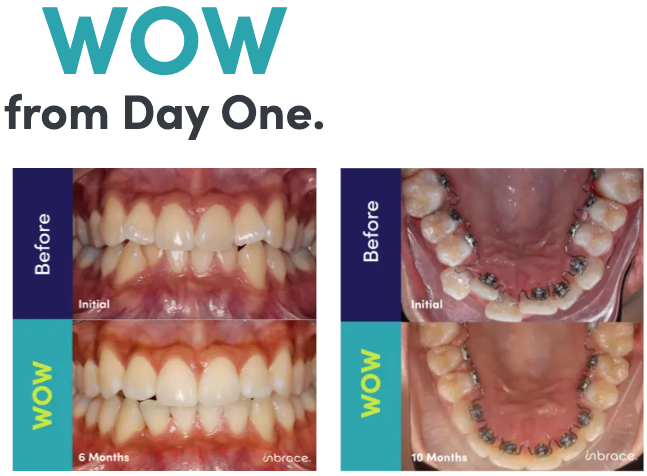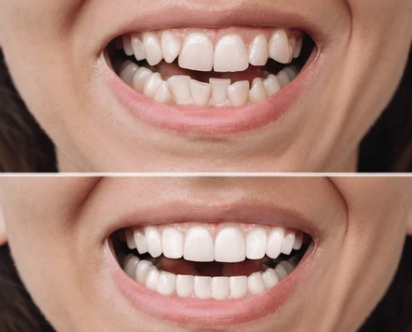
Orthodontics has come a long way since its inception, with various methods available to achieve a beautiful, functional smile. Among these methods, lingual braces have emerged as a popular choice for those seeking a discreet yet effective way to correct dental alignment issues. These braces are placed behind the teeth, making them virtually invisible and enhancing aesthetics. Ceramic braces also serve as an aesthetic alternative to lingual braces, providing effective orthodontic treatment without compromising on appearance. This article explores the benefits, technology, and considerations associated with lingual braces, offering a thorough understanding of why they might be the right choice for you.
What Are Lingual Braces Behind the Teeth?
Unlike conventional braces, which are mounted on the outer surface of the teeth and are more noticeable, lingual braces use lingual brackets that are customized to fit the inner surfaces of your teeth. This placement is what makes them a discreet alternative for orthodontic treatment.
Many individuals hesitate to choose conventional metal braces due to their impact on aesthetics, preferring nearly invisible options like lingual braces for a more discreet appearance.
How Do Lingual Braces Work?

Lingual braces function similarly to traditional braces, using customized lingual brackets and wires to apply gentle pressure on the teeth and guide them into proper alignment. The main difference lies in their placement. Traditional braces treatment involves metal brackets and elastic ties that are visible on the front of the teeth, whereas lingual braces are placed behind the teeth, making them less conspicuous. Here’s a brief overview of the process:
1. Initial Consultation and Customization:
During the initial consultation, the orthodontist will take impressions, photographs, and X-rays of your teeth and mouth. These records are used to create customized brackets and wires that are specifically designed to fit the lingual surfaces of your teeth. When choosing lingual braces, it is important to consider factors such as age, dental conditions, and suitability for different bite issues.
2. Bracket Placement:
The customized brackets used in lingual orthodontic treatment are bonded to the back of your teeth using a strong adhesive. The orthodontist carefully positions each bracket to ensure optimal results.
3. Wire Adjustment:
A thin wire is threaded through the brackets and adjusted periodically to exert gentle pressure on the teeth, gradually shifting them into the desired positions.
4. Regular Check-ups:
You will visit your orthodontist regularly for adjustments and to monitor the progress of your treatment.
Benefits of Lingual Braces

Lingual braces, often referred to as invisible braces, offer a discreet and aesthetic option for orthodontic treatment by being positioned at the back of the teeth. This makes them undetectable while effectively correcting dental issues, appealing to adults and teens who prefer a less noticeable alternative to traditional metal braces.
1. Aesthetic Discreteness:
The most significant advantage of lingual braces is their invisibility. Since they are placed on the back of the teeth, they are not visible when you smile or speak, making them an ideal choice for those who want to maintain a professional appearance during treatment. Wearing lingual braces offers a discreet orthodontic option with fewer lifestyle changes compared to labial braces, though it may involve unique challenges such as maintaining oral hygiene and possible speech difficulties.
2. Customized Fit:
Lingual braces are tailored to fit the unique contours of each individual’s teeth. This customization ensures that the braces work effectively and comfortably, minimizing discomfort and enhancing the overall treatment experience.
3. Effective for Complex Cases:
Lingual orthodontics can address a wide range of orthodontic issues, including severe overcrowding, spacing, and bite problems. Their design allows for precise adjustments, making them suitable for complex cases that may not be as effectively treated with clear aligners.
No Dietary Restrictions Unlike Traditional Braces
Unlike some other orthodontic treatments, lingual braces do not require significant dietary restrictions. You can enjoy your favorite foods without worrying about damaging the braces, as long as you maintain proper oral hygiene.
5. Improved Oral Hygiene:
Because lingual braces are positioned on the back of the teeth, they are less likely to interfere with brushing and flossing. With proper technique, you can maintain good oral hygiene throughout your treatment.
6. Boosted Self-Confidence:
Many individuals choose lingual braces to avoid the visible appearance of traditional braces. The discreet nature of lingual braces helps boost self-confidence and ensures that your orthodontic treatment remains private.
Inbrace Technology

Inbrace lingual braces are a cutting-edge orthodontic solution designed to correct misaligned teeth discreetly. Unlike traditional braces, which are fixed on the front surface of the teeth, Inbrace braces are attached to the back surfaces, making them virtually invisible from the outside. This innovative approach not only offers a more aesthetically pleasing option for adults and teens who are self-conscious about their appearance but also provides effective results.
The Inbrace system utilizes advanced technology and customized brackets to ensure a precise fit and efficient tooth movement. Each set of brackets is designed to work specifically for the patient’s unique dental structure, which helps in achieving optimal alignment with greater comfort. The braces are made from high-quality materials that reduce friction and allow for smoother adjustments during the treatment process.
One of the notable advantages of Inbrace lingual braces is the minimal impact on a patient’s daily life. Because they are hidden from view, users can go about their day without feeling self-conscious. Additionally, the design of Inbrace braces helps to minimize speech difficulties and irritation, which can sometimes occur with other types of braces. Overall, Inbrace lingual braces offer a discreet, efficient, and comfortable solution for achieving a straighter smile without compromising on appearance. Technology Behind Lingual Orthodontic Treatment

Lingual braces have advanced significantly since their inception. Modern technology has improved their effectiveness, comfort, and aesthetics. Key technological advancements include:
1. 3D Imaging and Computer-Aided Design (CAD): These technologies allow orthodontists to create highly accurate models of your teeth and plan the treatment with precision. This results in better-fitting braces and more predictable outcomes.
2. Custom-Made Brackets: Advances in bracket design and manufacturing mean that lingual braces are now more comfortable and less intrusive. Custom brackets are designed to fit the unique contours of each patient’s teeth, reducing irritation and enhancing comfort.
3. Low-Profile Brackets: Modern lingual braces feature low-profile brackets that are less bulky and more comfortable than older designs. This reduces the risk of irritation and makes it easier for patients to adjust to wearing braces.
4. Advanced Wires: High-tech wires that are more flexible and durable contribute to more effective tooth movement and a smoother treatment experience.
Considerations and Challenges
While lingual braces offer numerous benefits, they may not be suitable for everyone. Here are some considerations and potential challenges:
Oral Hygiene
Maintaining proper oral hygiene is crucial when using lingual braces. It is important to prevent tooth decay by thoroughly cleaning your teeth, as food can become trapped in the braces, leading to plaque build-up. Using specialized tools and techniques can help ensure that tooth decay does not occur during orthodontic treatment.
Initial Discomfort:
Lingual braces can cause temporary discomfort and a sensation of fullness in the mouth, particularly during the initial adjustment period. This is due to their placement on the tongue side of the teeth.
Speech Difficulties: Some patients may experience temporary speech difficulties or a slight lisp when they first get lingual braces. However, most individuals adapt to these changes within a few weeks.
Cost: Lingual braces tend to be more expensive than traditional braces and clear aligners. The cost is attributed to the customization and technology involved in their design and manufacturing.
Oral Hygiene: While lingual braces are less likely to interfere with brushing and flossing, the back placement of the brackets can make cleaning more challenging. Patients need to be diligent about their oral hygiene routine to prevent plaque buildup and other dental issues.
Maintenance and Adjustments: Lingual braces may require more frequent adjustments and maintenance compared to other orthodontic treatments. Regular visits to the orthodontist are essential for ensuring that the treatment progresses as planned.
In conclusion, lingual braces are an effective option for straightening teeth, offering a discreet solution that aligns with the overall goal of achieving a proper bite and long-lasting dental health.
Conclusion

Lingual braces represent a significant advancement in orthodontic technology, offering a discreet and effective solution for those seeking to improve their dental alignment without the visibility of traditional braces. Their benefits, including aesthetic discreteness, customization, and suitability for complex cases, make them a compelling option for many patients. However, it’s essential to consider the potential challenges, such as initial discomfort, cost, and oral hygiene maintenance.
If you’re considering lingual braces, consulting with an experienced orthodontist can help determine whether they are the right choice for your individual needs and goals. With the right care and commitment, lingual braces can help you achieve a beautiful, healthy smile with minimal impact on your daily life.

